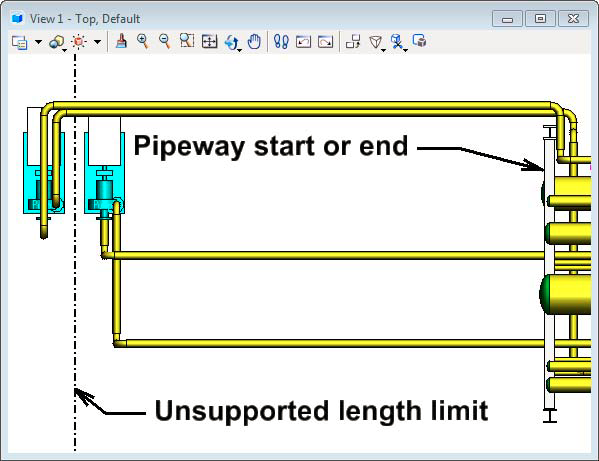Free Space Routing
The AutoRouter routes free space pipes and segments before routing pipeway pipes and segments.
In free space, the router searches for a path that minimizes pipe length and the number of bends. In order to choose from among a set of potential routes, the Free Space Router assigns a cost to the length of the route and a cost to each bend along the route and chooses the route with the lowest total cost. The router is greedy, which means that a routed pipe occupies the best space available without regard for subsequent pipes. Vicinity routing rules can be used to offset the greedy nature of the router.If the pipe is a non-pocketing pipeline, the pipe is routed without high or low pockets. If a non-pocketing route can not be found, then the pipeline is routed without concern for pockets and flagged as an exception line.
Routing Order
- First, the Router decides
which pipelines and segments are
routable.
- All pipelines that have both ends connected either to a placed nozzle or a placed tee are routable.
- All pipelines that have one end connected to a placed nozzle or a placed tee and the other end connected either to a tee that has been determined to be on a pipeway or to a boundary component are also routable.
- All pipeline segments that have one end connected to a placed nozzle or a placed tee and are determined to go to a pipeway drop zone are also routable.
- Next, the router selects the routable pipe with the highest priority. See "Priorities" section, next. ).
- Then, the router decides whether the pipe should route directly or to a pipeway. See "Routing to a Pipeway" section, next.).
- Finally, the router routes the pipe.
Priorities
Routing to a Pipeway
If the first distance is less than either of the other two, the pipe will route directly. You can override a pipe’s category (direct or pipeway) in the Pipeline Editor dialog.
When determining whether a pipeline should route to a pipeway, the router also decides which pipeway(s) to use.
When equipment is located such that a nozzle is within the column lines of the pipeway and less than the approximate unsupported length for the connected pipe’s nominal diameter the pipe will route directly to the pipeway as shown.
When the length exceeds the approximate unsupported length for the connected pipe’s nominal diameter the pipe will route to enter the pipeway from the side.
Routing Rules
Pipeline routing relies significantly on basic pipe-routing rules – piper practices – and produces reasonable routes that emulate those a piper might produce. These routes are not necessarily the shortest routes.
In free space, pipes are routed in the shortest possible path that the router can find. You can influence to what extent that the router will search for a free space route. From the AutoRouter Control dialog, you can slide the bar on the lower right hand corner of the dialog to select a percentage of how much time the AutoRouter will spend searching for a path.
Routing is, in general, orthogonal. Exceptions are made at pipeline starts and ends where routing is in the direction of the connected nozzle. In addition, large pipes may be routed with 45° elbows to change elevation when an orthogonal route is not possible.
Another exception to the orthogonal routing rule takes place in the short router. For the limit of an allowable unsupported pipe span, the short router can skew a pipe route to minimize the length of a route.
Pipelines are routed to avoid obstacles. Each piece of equipment, each structure, each access and maintenance area and each routed pipeline is an obstacle for subsequently routed pipelines. Only pipelines that go to nozzles on equipment objects may penetrate that equipment’s obstacle space without generating an exception.
Pipelines are placed to take two spacing variables into account. Those variables are the minimum centerline spacing and the bottom-of-pipe offset for insulated pipes. The calculations of these values is discussed in "Pipeline Spacing". If a line cannot meet these two criteria, an exception is generated.
Horizontal pipeline segments approaching the pipeway are routed so that the bottom of the segment – or the bottom of the insulation shoe of an insulated segment – lies on a routing plane. The free space router stops the to-pipeway segments at the centerline of the pipeway column or at the edge of the pipeway space if there are no columns.

